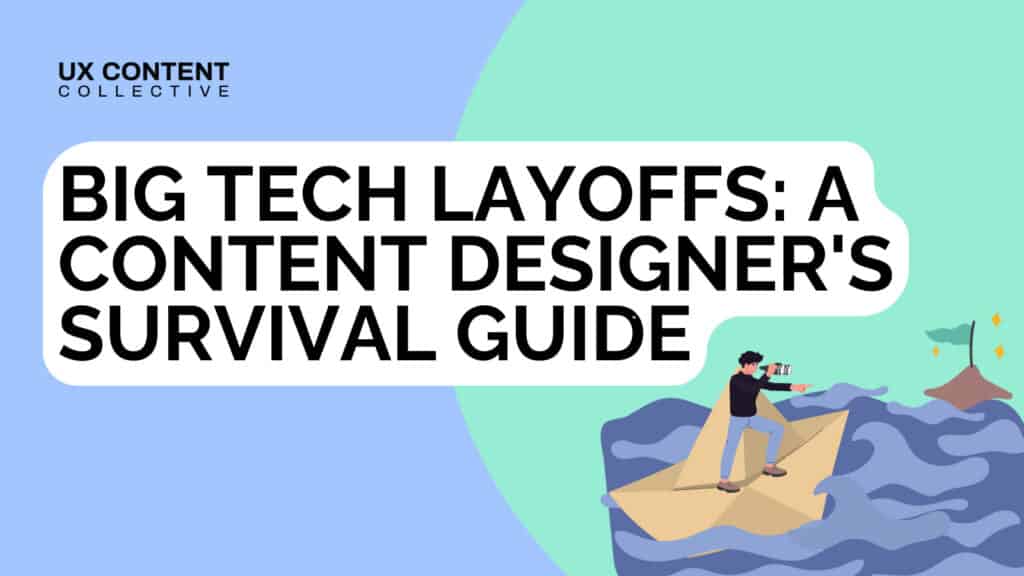

I graduated university in 2008, roughly the same time the entire world economy collapsed. As many millennials would know from that time period, trying to get a job let alone a well paying job was a struggle. I managed to survive by attaching my career to a growing field (digital journalism) but it wasn’t easy.
The current economic downturn isn’t as bad as 2008, but appears to be more like the dot-com bust of the ‘90s. The layoffs we saw earlier this year at places like Shopify have continued:
Now to be frank, much of the impact here will be felt by developers, PMs, engineers, and other tech roles. But as anyone who has gone through rounds of layoffs knows, layoffs are just a lagging indicator of increased scrutiny across all levels of an organization. Which means UX writers and content designers need to realize something:
Although the hyperbole on social media makes us believe we’re in a perpetual state of fear and turmoil, the global economy (particularly around tech) has been unbelievably good for the past decade. It was never easier to get in, get trained, and get good. That situation was untenable and we’re now seeing changes.
As a UX writer or content designer that means you have specific concerns beyond a vague economic threat. It means that your economic survival and future is dependent on your ability to demonstrate specific value. It also means that more will be expected of you…and here’s the important part: no one is going to specifically ask you to do this. It’s on you to anticipate this change, realize it, deal with it, and then make an actionable plan to increase your value.
So how do you do that? I can’t provide you with all the answers but here are some points that might help:
You need to make it as hard as possible for managers / others to put your name on a layoff list. Usually articles like this tend to stay in vague territory and speak in platitudes, but here are some specifics:
At this point I should add all of this is dependent on your emotional and mental wellbeing and availability. Adjust as necessary.
We all know the normal things. Hit your deadlines. Write well. Make sure your strings are solid and you thoroughly understand the product you’re working on (less common than you’d think). But you should also emphasize these things:
That brings us to something else.
For more on this I’d recommend checking out Yael Ben David’s upcoming book, The Business of UX Writing, but for now consider this: if your achievements do not include numbers, then you’re doing something wrong.
Your achievements need to match your OKRs, and those need to match the organization’s OKRs. You need to tie every single one of your projects and achievements to the larger goal.
Let’s say you work for an insurance company, and one of your organization’s goals is to increase market share. Perhaps one of the ways your company measures that OKR is through customer retention. Now, let’s say you work on a project where you re-worked push notifications related to in-app activity. Many UX writers or content designers tend to write their achievements like this:
…fine? It’s okay. Worse: an example of a content designer or UX writer who doesn’t understand strategic value. Your problem is not the solution. Think broader. In times like these your ability to think strategically is paramount. Your “problem” is much bigger than you think and it pertains to your organization not your individual project. Let’s rewrite it:
This solution is vague enough that you’re not boxing yourself into any one solution (but this isn’t an article about the double diamond process, so let’s move on). Your push notifications are your solution. Your results are longer-term, and you might have to rely on cross-collaboration to get them. You might have to ask a data analyst to get them for you (oh, and if you thanked them for the dashboard that nobody reads, they might just be a little more willing to get you that information).
Keep in mind that there will always be a link between user problems and organizational problems. Call that out. Show how you have addressed the organizational problem where possible.
So your results look like this:
I can’t give you a definitive list of figures that you can use, but think broadly. Can you represent your value in:
Keep in mind, every single metric you measure can be represented in some form of monetary value. If you’re saving time, you’re also saving money — just figure out how to represent minutes as dollars.
When applying for jobs, asking for promotions, etc, examine all the bullet points in a job description. Make sure you can put numbers against every single one.
Some other things you need to keep in mind:
I realize it’s somewhat biased of me to say this considering I help run a business that sells courses, but it is more important to level up. This doesn’t mean paying money. It means reading, being knowledgeable, watching webinars and understanding deeper topics like accessibility or string database management (again, for the purpose of providing exponential value). But more importantly, don’t just “learn” for the sake of learning. Be targeted in your learning and understand what you’ll be able to apply to your day to day work.
I hate to use the word “competing”, but you really are competing against others for jobs. The more points you have in your skills and achievements column the better.
This may seem difficult to believe, but it has actually been easier in the past few years to get a job at large tech companies. The gate is going up, so you might have more success down the road going into a role at a start-up as the first or second content designer. This obviously means there is greater pressure on you to perform and demonstrate value, so do consider carefully whether you think you can do that job. But I would consider a role at a start-up more seriously than in the past.
There has been a flux of entrants from other careers coming into UX writing and content design. That’s a fantastic thing. But tech is maturing, social media is changing, and our industry is now expected to demonstrate value more than ever. As Winston Churchill said, this isn’t the beginning of the end…it’s the end of the beginning, and there is much more to come. Be ready.
Get our weekly Dash newsletter packed with links, regular updates with resources, discounts, and more.
